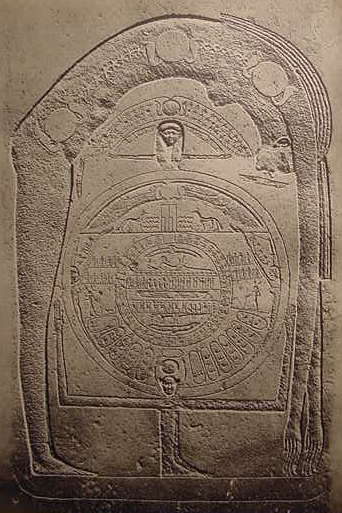The Nile River portrayed in a Circular Format. The Egyptians understood, in their myths, that the Nile was a great river that not only existed on earth, but in Heaven as well. It was conceived as being Circular. The Ocean which the Nile emptied into was part of the great Circular Nile. The Nile in Egypt was also understood to arise from the Ocean which circled the earth, being part of heavenly Nile. This bas-relief is from a Sarcophagus of a priest from Sakkara. 30th Dynasty, ca. 350 BCE. However, fragments of a similiar representation of the circular Nile exist from New Kingdom times. The sky-goddess, Nut, is portrayed with her body arched over the Circular Nile. Breasted noted that the Greek's idea of Freshwater River Ocean/Okeanus, which encircled the earth and was the source of ALL fresh water rivers was probably derived from the Egyptian concept of the Ciruclar-Heavenly Nile, of which the Ocean was a part. The Jewish histrorian, Josephus writing ca. 80 CE, stated that the RIVER OF EDEN ENCIRCLED THE EARTH AND WAS THE SOURCE OF FOUR RIVERS, the Pishon, Gihon, Euphrates and Tigris. The Babylonians understood the Euphrates and Tigris to emanate from a great river encircling the earth which they called the Bitter River, identified with the Persian Gulf and Mediterranaen Sea. I have posited that the River of Eden takes its name from the Gulf of Aden, part of the great freshwater ocean encircling the world in Egyptian and Greek myths. Pre-Exilic Judah may have picked up the notion of the Ocean being a great freshwater stream and source of all freshwater rivers from Ionian Greek mercenaries from Egypt, stationed in Palestine and Judah in the 7th century BCE. Thus a Greek-Egyptian concept entered the Hebrew Bible's Genesis account written ca. 562/561 BCE in the Exile.
(Plate 209. J.H. Breasted. Geschichte Aegypytens. Zurich. Phaidon Verlag. 1954)
To the viewer's right is a pen and ink rendering of the above Circular Nile (cf. p.38. fig. 33. Othmar Keel. The Symbolism of the Biblical World, Ancient Near Eastern Iconography and the Book of Psalms. New York. The Seabury Press. 1978)
To the viewer's right, a fragment of the "Circular Nile" from New Kingdom (18th Dynasty times ?). (cf. p. 40. fig. 34. Othmar Keel. The Symbolism of the Biblical World, Ancient Near Eastern Iconography and the Book of Psalms. New York. The Seabury Press. 1978).
Note this fragment appears as a black and white photograph accompanied by a pen and ink sketch in J.J. Clere's article on a New Kingdom representation of the World ( J.J. Clere. "Fragments d'une Nouvelle Representation Egyptienne du Monde in Festshrift H. Junker II. Teil, MDAIK 19, 1958, 30 pp. [MDAIK = Mitteilungen des Deutschen Archaologeischen Institutes Abteilung, Kairo])
Please click here for a picture of Hapi (Hapy) the Egyptian god of the Nile at Aswan holding two vases from which pour the waters of the subterranean Nile, symbolizing the Nile's emergence via two caverns or spring-holes.
